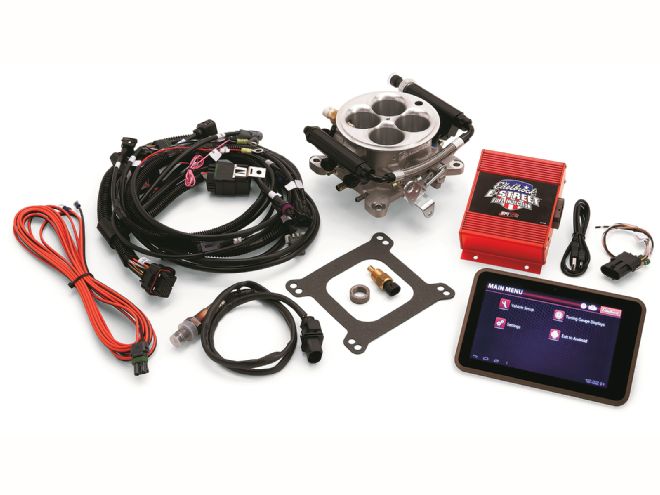
A quarter century ago, first-generation EFI systems were expensive, difficult to install, and even harder to tune—if you could even understand what was going on in the first place. It wasn't so bad once you got the hang of it, but the learning curve was steep, and right or wrong, news quickly spread that EFI was no easy bolt-on. The negative reputation dogged EFI for decades, but so did the benefits on the plus side. Those benefits, such as sharp throttle response, great driveability, good cold-start manners, and superior fuel economy with no trade-off in performance, enticed EFI engineers to double their efforts, and now we are in a fuel-injection renaissance with third-generation technology. The fact is, you can't do too badly with any of the new systems on the market; that's because manufacturers now know that many consumers (who may have been watching from the sideline) want aftermarket EFI systems that are simpler to install and that do not require a laptop to program them. As a result, today's third generation of EFI systems often have some kind of self-learning strategy to take away the headache of manually filling in fuel load values cell by cell, column by column, row by row. As far as we're concerned, self-learning is the future of EFI, and there's almost no reason not to go that route, especially since there's no real cost attached to it.
Introduced just last year, Edelbrock's E-Street EFI (PN 3600, street price around $2,200) is turning out to be one of the hottest value-packed sellers in the self-learning EFI marketplace. Its four 60-lb/hr injectors feed a cast-aluminum throttle body that bolts to any traditional intake with a square-bore 4150-sized mounting flange. At the system's nominal 60 psi operating pressure, the E-Street system can safely supply naturally aspirated engines up to 600 hp, enough to cover the vast majority of hot rodders. Moreover, Edelbrock has helped simplify the process by mounting most of the essential sensors and actuators right on the throttle body, making the task of wiring and harness routing a minor affair. (The connections for the injectors, idle air bypass, manifold absolute pressure sensor, air inlet temp sensor, and throttle position sensor all terminate at the throttle body.) Only the wide-band oxygen sensor and the coolant temp sensor are mounted off the unit. The base kit comes with the pre-assembled throttle body, ECU (the control box), a pair of relays, harnesses, wideband O2 sensor, all mounting hardware, and most intriguing of all, a 7-inch Android tablet with wireless capability.
The tablet is the rock star in the E-Street show, making incredibly light work of the traditionally laborious job of loading and tuning the ECU. And while competing units offer handheld programmers, the E-Street unit communicates on a wireless Bluetooth channel with the ECU allowing you to load tunes and do setup from virtually anywhere. With the Android tablet's wifi connectivity, you can even access Edelbrock's I-Link tech support, allowing Edelbrock technicians to see your screen and engine performance in real time and even make tuning changes if necessary. The resolution of the full-color 7-inch display is exactly what you'd expect from a high-end retail Android tablet—because that's exactly what it is. (No more squinting at hard-to-read boxes with sketchy block-pixel displays. A big plus for us older guys with not-so-good eyesight.)
The tablet comes with a sturdy suction cup bracket that allows it to be easily attached to the dash or windshield; an antiglare screen shield and vehicle DC power adapter make it even more hot rodder friendly. Once the setup procedure and base program download is complete, you can stow the tablet, or use it for other nonautomotive purposes, however, we liked having it onboard during the self-learning period to see the progress of the fuel corrections. (As the ECU learns the engine, the amount of fuel correction above or below the base fuel map is displayed in percentage points of correction. It was fun to watch the correction factor get smaller over time and to feel that improvement through the seat of our pants.)
When it comes to EFI installations, the elephant in the living room is the fuel system. You can have all the fancy pants hardware underhood, but at the end of the day, you're still yanking the gas tank, installing an electric fuel pump, running fuel line, and wiring a relay-equipped power supply to the new pump. And even with that accomplished, more than half of all EFI conversions on classic muscle cars suffer from fuel starvation unless more steps are taken to sump the fuel pump pickup (protecting it from sucking air on modest cornering or braking). We've covered the subject (and the fix) numerous times, but Edelbrock's Universal Fuel Sump Kit (PN 3605, 60 psi; and PN 3607, 49 psi; street price $546) is a solution so cost-effective, functional, and simple, we're amazed nobody thought of it sooner. When we first saw it, we knew we had to do a separate story just on this kit (turns out, it can be used with any aftermarket EFI system, not just E-Street), so we'll be bringing that to you shortly.
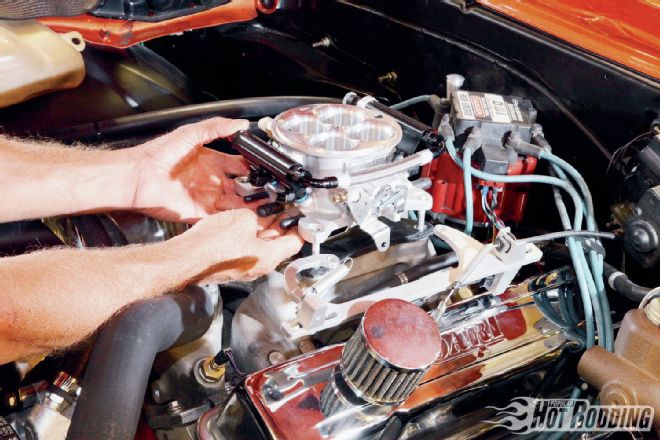 1. Simplifying the E-Street’s installation is Edelbrock’s throttle-body assembly, which comprises the bulk of all the connections to the ECU. Four 60-lb/hr injectors running with a returnless fuel system can feed up to 600 hp naturally aspirated. The 4150-style footprint means it will fit on virtually any carbureted intake.
1. Simplifying the E-Street’s installation is Edelbrock’s throttle-body assembly, which comprises the bulk of all the connections to the ECU. Four 60-lb/hr injectors running with a returnless fuel system can feed up to 600 hp naturally aspirated. The 4150-style footprint means it will fit on virtually any carbureted intake.
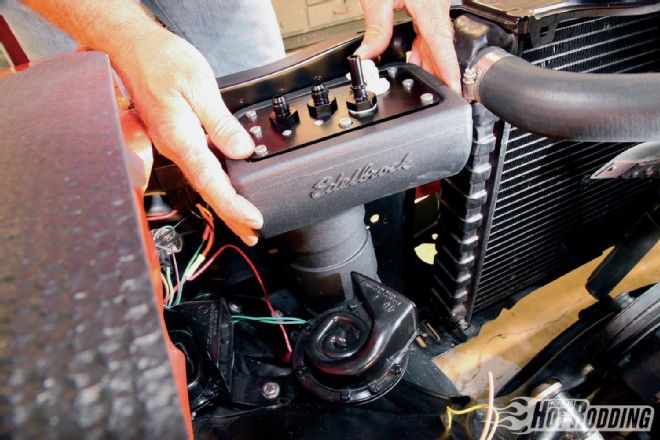 2. Edelbrock’s Universal Fuel Sump Kit (PN 3605, street price $546) can feed up to 600 hp through a returnless fuel circuit. It’s fed by a stock-style block-mounted mechanical fuel pump and is pure genius. We’ll have the full story down the road, but this kit was a lifesaver; we were able to retain our existing fuel system without replacing the tank, adding an in-tank pump, or plumbing new fuel lines to the rear of the car.
2. Edelbrock’s Universal Fuel Sump Kit (PN 3605, street price $546) can feed up to 600 hp through a returnless fuel circuit. It’s fed by a stock-style block-mounted mechanical fuel pump and is pure genius. We’ll have the full story down the road, but this kit was a lifesaver; we were able to retain our existing fuel system without replacing the tank, adding an in-tank pump, or plumbing new fuel lines to the rear of the car.
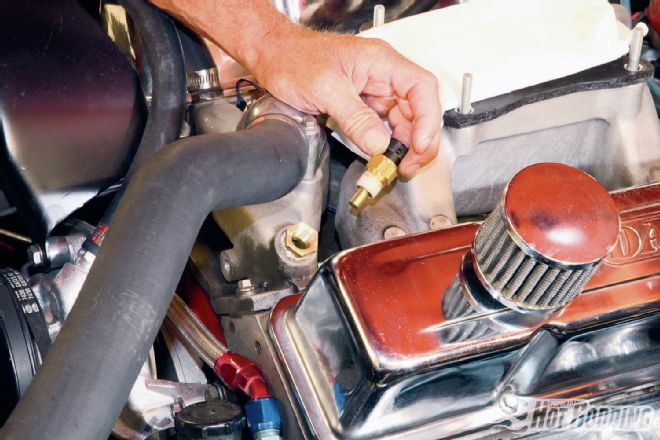 3. The only sensor that needs mounting on the engine is this supplied coolant temperature sensor.
3. The only sensor that needs mounting on the engine is this supplied coolant temperature sensor.
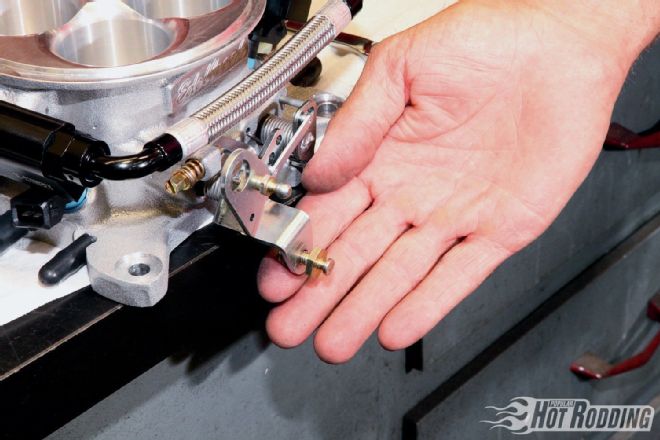 4. The old throttle linkage parts can be transferred from your old carb to the Edelbrock throttle body. This move means you can retain all your connections for the throttle cable and trans kickdown/TV cable.
4. The old throttle linkage parts can be transferred from your old carb to the Edelbrock throttle body. This move means you can retain all your connections for the throttle cable and trans kickdown/TV cable.
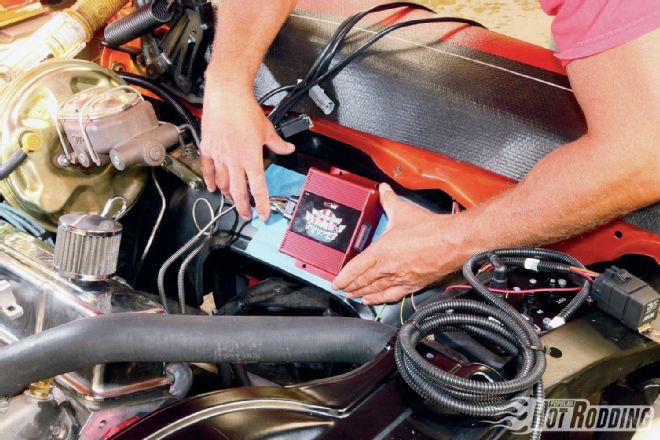 5. The heart of the E-Street system is the ECU box. The kit harness is long enough to allow being mounted in the cockpit, on the firewall, or under the dash, but we opted for the engine bay. The unit can handle the heat and moisture, so we wanted to show it off when we pop the hood.
5. The heart of the E-Street system is the ECU box. The kit harness is long enough to allow being mounted in the cockpit, on the firewall, or under the dash, but we opted for the engine bay. The unit can handle the heat and moisture, so we wanted to show it off when we pop the hood.
Until then, here's the short version: The Universal Sump Kit consists of a powerful electric fuel pump inside a small crosslink polymer tank that mounts in the engine compartment. The sump tank is fed by the engine's mechanical fuel pump and is internally baffled to withstand extreme g-force without uncovering the pump's pickup. It also makes an attractive addition underhood. Moreover, the system is returnless, negating the need for any return lines to either the Edelbrock sump or the stock tank in the back of your car. The sump/pump assembly is internally regulated and has internal floats to open and close the flow of fuel from the mechanical pump to the sump. Irrespective of price, we know of no fuel system on the market that does a better job of feeding an EFI engine up to 600 hp, and our unit worked just as advertised.
Installation
Mating the E-Street system to our 522hp 400ci small-block Chevy was straightforward. After mounting the universal sump tank to the radiator support, the carburetor was removed and replaced with the E-Street throttle-body assembly. Next comes mounting the ECU, which may be mounted anywhere in the car. (We elected to place it in the engine compartment for some visual pizzazz, but the cockpit is also an excellent choice.) Connection for the injectors, throttle position sensor (TPS), idle air control (IAC), manifold absolute pressure (MAP), and inlet air temp (IAT) are all clearly called out on the main harness, and attach to the throttle body assembly via waterproof weatherpack connectors. An ECU power connection must be made that delivers power with the key on and during cranking, and two relays must be mounted to provide power to the injector driver circuit and the sump's fuel pump. (Both relays use quick connectors to the ECU harness.) Beyond that, you'll need to install a coolant temp sensor in the intake manifold, make provisions for the wide-band O2 sensor in the header collector, and connect your vacuum lines to the throttle body (brake booster, transmission modulator, PCV, etc.). Lastly, a healthy tach signal must be fed to the ECU, which we picked up from our HEI. Our Nova project car has a mechanical fan, but the E-Street supports electric fan control through a connector on the harness, should you need it. The throttle and transmission linkage from your old carburetor will work too; just transfer your linkage components to the E-Street throttle body from the carburetor.
Setup & Fuel Map
The E-Street's Android tablet comes preloaded with several base tunes, and after a short procedure to calibrate the TPS, you're prompted to answer some basic engine configuration questions such as displacement, ignition type, camshaft duration, accelerator pump shot, cooling fan threshold, and rev limit. The tablet will then wirelessly download the right base map to the ECU. (The engine icon on the tablet will light up with a green check mark whenever it's communicating with the ECU.) The E-Street ECU has user-defined set points for the air/fuel ratio for idle, cruise, and WOT; these may be tweaked during setup, or changed on the fly. Set points are the target that the ECU will use to fine-tune the fuel map on its own, so if you give it something unrealistic (like 14:1 at WOT), be prepared to suffer the consequences. (Edelbrock sets up the tablet with safe air/fuel ratio set points that make a good starting point, so you really don't have to change them unless you want to.) We found the setup to be intuitive, and we were up and running in a very short period of time.
All that remains is the fun part: driving it. Right at the turn of the key, our base map was already delivering cold start and idle characteristics that were superior to the carburetor. That's saying a lot, since our camshaft is huge (it's a hydraulic roller with 243/257 degrees duration at .050, delivering only 4 inches of vacuum at idle). With the tablet mounted in the cockpit via the provided suction cup mount, we drove the Nova for several days, making every attempt to drive through every rpm point at every load from light throttle to WOT as well as high-vacuum, high-rpm engine braking. We made no adjustments on the tablet, in fact, the tablet isn't even required at this point. It does, however, provide a very effective visual display of the air/fuel ratio set point, the actual air/fuel ratio, and the fuel correction in percentage points. (Fuel correction figures are initially high upon first start-up and first drive, and gradually get lower as the ECU learns.) There are also dials for rpm, coolant temp, and engine vacuum.
The E-Street ECU is constantly learning and fine-tuning the fuel map; the longer you drive it, the sharper the throttle response and the harder the hit when you mash the loud pedal. The tablet is essentially along for the ride, allowing you to make small tweaks as necessary to things like the idle rpm, air/fuel ratio target, rev limit, pump shot size, and pump shot duration. Moreover, each cold start you get under your belt (basically one per day) makes it that much more transparent each morning. One more cool thing: Taking the tablet out of the car does not stop the ECU's learning process. That's ongoing whether the tablet is in the car, or in your man cave surfing the Internet, which it does quite well.
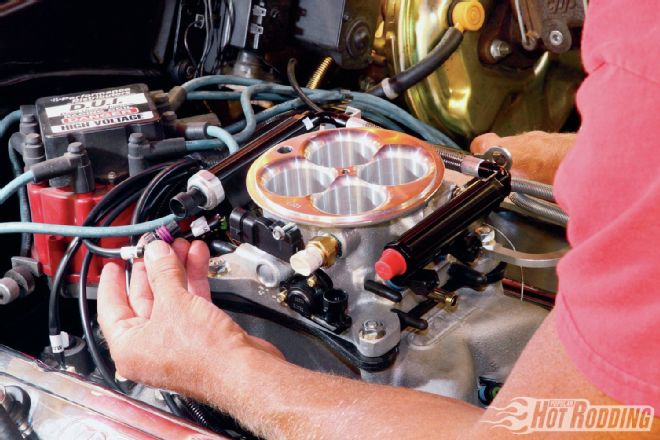 6. After you know where the ECU will be, you can bolt the throttle body to the intake and make all the harness and vacuum connections to the throttle body. All the harness leads are clearly labeled for injectors, IAC, IAT, MAP, and TPS. They just snap right on.
6. After you know where the ECU will be, you can bolt the throttle body to the intake and make all the harness and vacuum connections to the throttle body. All the harness leads are clearly labeled for injectors, IAC, IAT, MAP, and TPS. They just snap right on.
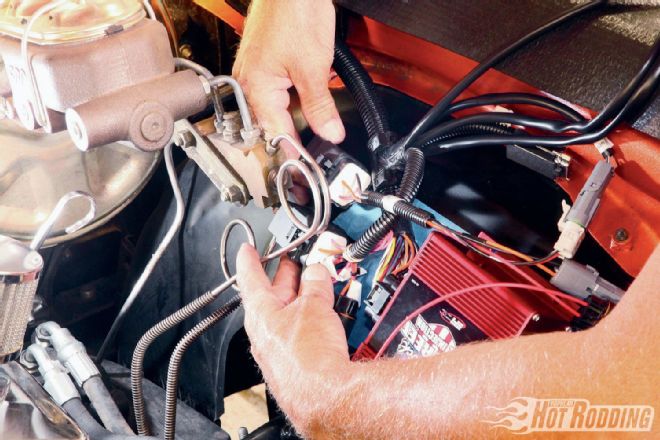 7. Two relays—one for the injector driver circuit and one for the electric fuel pump—must be mounted in the engine bay. (Harness length is the only limiting factor.) We found two existing holes in our inner fender next to the ECU, so we mounted them there. Edelbrock provides individual harness leads for these.
7. Two relays—one for the injector driver circuit and one for the electric fuel pump—must be mounted in the engine bay. (Harness length is the only limiting factor.) We found two existing holes in our inner fender next to the ECU, so we mounted them there. Edelbrock provides individual harness leads for these.
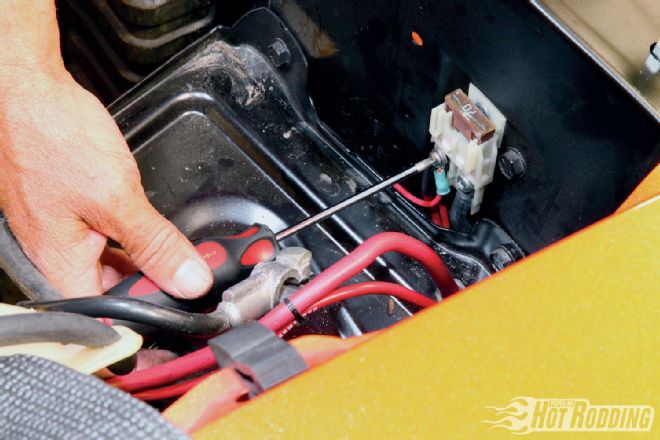 8. Both relays will need a decent shot of juice straight off the battery (the key-on hot wire seen later in the story is only the arming trigger for the ECU). We tapped into the main buss fuse we added earlier when we rewired the Nova (it’s in front of our battery on the radiator core support).
8. Both relays will need a decent shot of juice straight off the battery (the key-on hot wire seen later in the story is only the arming trigger for the ECU). We tapped into the main buss fuse we added earlier when we rewired the Nova (it’s in front of our battery on the radiator core support).
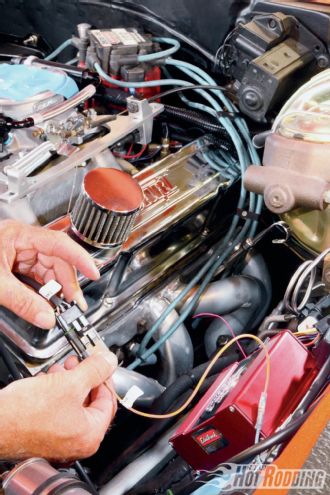 9. The ECU needs a solid tach signal, which we picked up from our HEI unit. Note that not all HEIs are the same. Should your aftermarket HEI or ignition module present a problem, Edelbrock can supply the correct tach signal conditioner. The E-Street works well with multi-strike CD ignitions too.
9. The ECU needs a solid tach signal, which we picked up from our HEI unit. Note that not all HEIs are the same. Should your aftermarket HEI or ignition module present a problem, Edelbrock can supply the correct tach signal conditioner. The E-Street works well with multi-strike CD ignitions too.
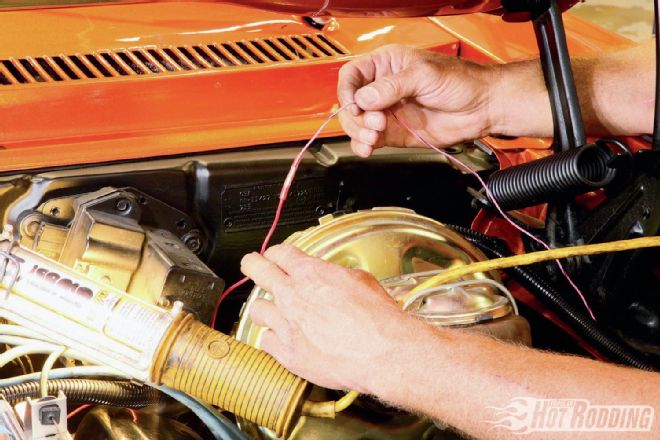 10. You’ll need to pick up a 12V hot wire to run the ECU—this one was taken off the HEI supply. Make sure you test for cranking power with a test light. Be aware that some key-on power sources will show key-on power, but do not have power during cranking.
10. You’ll need to pick up a 12V hot wire to run the ECU—this one was taken off the HEI supply. Make sure you test for cranking power with a test light. Be aware that some key-on power sources will show key-on power, but do not have power during cranking.
Conclusion
The E-Street offers a ton of value for the dollar without forcing a bunch of pro-level bells and whistles down your throat. Yet it does offer enough flexibility and features to meet 95 percent of hot rodders' needs without dumping a ton of complexity and cost on your head. The tablet is a big plus (easy step-by-step installation and setup instructions are programmed right in), and the optional Universal Fuel Sump System makes it a 100 percent engine bay–only operation that can be handled in the average Joe's home garage. Even with the Universal Fuel Sump System included, your take-home cost on the E-Street is under $2,800 (street) making it an outstanding value as well.
A couple of biggies we noticed after our initial week of city/highway driving. Our old carb had a hard time metering fuel at low rpm and cruise due to a weak booster signal from low engine vacuum. The E-Street just didn't care once it had learned that part of the table. Under hard braking, our old carb would stop supplying fuel, stalling the engine, while the E-Street now keeps the fire lit. Cold starts no longer involve tricky stabs of the gas pedal to keep the engine running—even though the old carb had an electric choke. The E-Street fires and runs when cold, no monkey motion required. The un-tunable hole in the midrange part of the carburetor's fuel curve that caused the stumble is gone, again an artifact of the big cam and poor booster signal. As you might imagine, the E-Street has banished all softness from the throttle tip-in with immediate, neck-snapping fuel enrichment. Yet on the fuel economy front, we went from getting 14 mpg with the carb on our highway loop (yes, that was with overdrive), to 18.5 mpg with the E-Street EFI, an improvement of 32 percent over the 750-cfm carb.
If you've been on the fence with EFI, the Edelbrock E-Street system will surely make the decision a no-brainer. And if it doesn't, there probably isn't much hope for EFI in your car's future, because it couldn't get any easier than this.
More Online!
Our E-Street installation was performed at Edelbrock's R&D and Testing facility by Edelbrock EFI engineer Mark Honsowetz. Log on to PopularHotRodding.com to check out two in-depth videos of the installation and setup of the E-Street EFI on our 1968 Nova—there's a lot more there that we couldn't fit into our story, plus some bonus footage of some cool upcoming stuff from Edelbrock. And don't miss the Nova's felony burnout when the E-Street's self-learning is complete!
E-STREET EFI OPTIONS E-Street kit description: Kit PN: Base system without fuel supply system 3600 Base system, includes Returnless-Style Fuel Kit 3603 3601 Base system, includes Return-Style Fuel Kit 3604 3602 Base system, includes Universal EFI Sump Fuel Kit 3605 3606
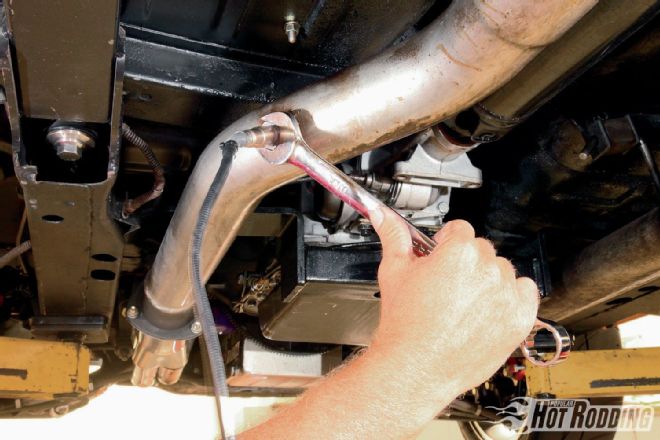 11. The amazing fuel control of the E-Street system comes from the wide-band O2 sensor, which needs to be mounted in the exhaust gas stream. You’ll need to weld the included O2 bung into your exhaust before starting the job at home—most exhaust shops can do it for $30 or so. Installing the wide-band O2 and plugging in the harness wire is the easy part.
11. The amazing fuel control of the E-Street system comes from the wide-band O2 sensor, which needs to be mounted in the exhaust gas stream. You’ll need to weld the included O2 bung into your exhaust before starting the job at home—most exhaust shops can do it for $30 or so. Installing the wide-band O2 and plugging in the harness wire is the easy part.
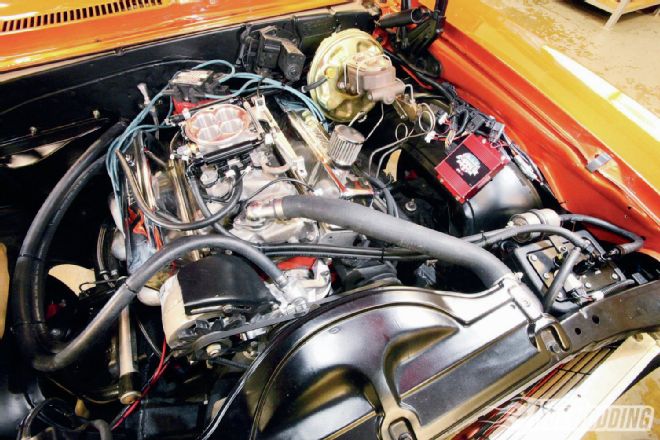 12. Here is the finished E-Street installation. If the stock-style air cleaner was bolted on, you’d never know there was anything different, save the ECU and cool-looking fuel sump. And, of course, the searing performance.
12. Here is the finished E-Street installation. If the stock-style air cleaner was bolted on, you’d never know there was anything different, save the ECU and cool-looking fuel sump. And, of course, the searing performance.
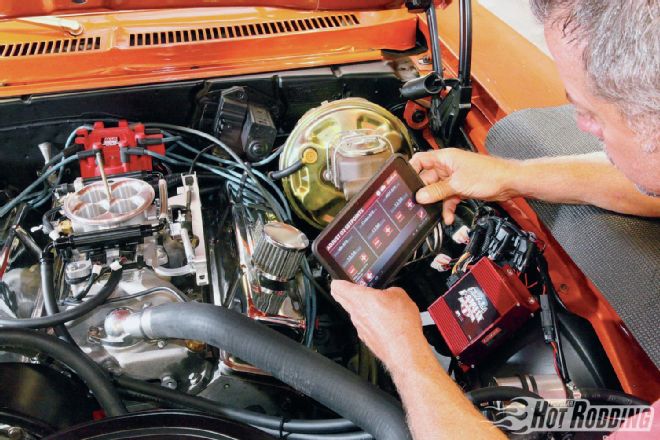 13. Before firing it up, you need to calibrate the TPS and answer a few easy questions on the setup menu in the E-Street’s Android tablet. When that’s done, the tablet automatically selects the best base fuel map in its memory, and downloads it to the ECU through a wireless Bluetooth link.
13. Before firing it up, you need to calibrate the TPS and answer a few easy questions on the setup menu in the E-Street’s Android tablet. When that’s done, the tablet automatically selects the best base fuel map in its memory, and downloads it to the ECU through a wireless Bluetooth link.
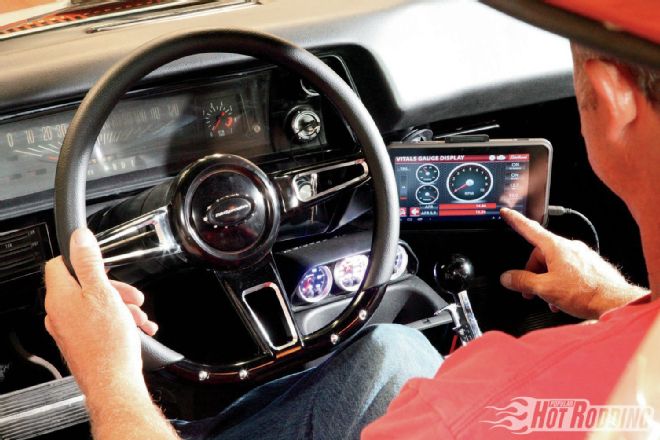 14. The E-Street wireless tablet can be mounted inside the car during the idle adjustment and self-learning testdrives; the easy-to-read display shows you how much the wide-band is correcting to fine-tune the fuel map. A choice of display screens can be selected from—this one shows engine rpm, engine vacuum, coolant temp, air/fuel ratio set point, actual air/fuel ratio, and active correction percentage. During the self-learning process you can see the ECU learning the fuel table and feel the result through the seat of your pants at the same time. It’s very cool when that happens.
14. The E-Street wireless tablet can be mounted inside the car during the idle adjustment and self-learning testdrives; the easy-to-read display shows you how much the wide-band is correcting to fine-tune the fuel map. A choice of display screens can be selected from—this one shows engine rpm, engine vacuum, coolant temp, air/fuel ratio set point, actual air/fuel ratio, and active correction percentage. During the self-learning process you can see the ECU learning the fuel table and feel the result through the seat of your pants at the same time. It’s very cool when that happens.